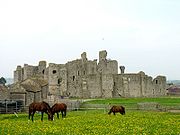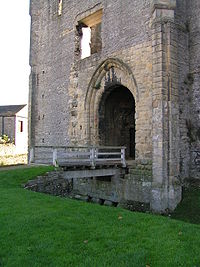
Middleham Castle
Encyclopedia

Wensleydale
Wensleydale is the valley of the River Ure on the east side of the Pennines in North Yorkshire, England.Wensleydale lies in the Yorkshire Dales National Park – one of only a few valleys in the Dales not currently named after its principal river , but the older name, "Yoredale", can still be seen...
, in the county of North Yorkshire
North Yorkshire
North Yorkshire is a non-metropolitan or shire county located in the Yorkshire and the Humber region of England, and a ceremonial county primarily in that region but partly in North East England. Created in 1974 by the Local Government Act 1972 it covers an area of , making it the largest...
, was built by Robert Fitzrandolph, 3rd Lord
Lord
Lord is a title with various meanings. It can denote a prince or a feudal superior . The title today is mostly used in connection with the peerage of the United Kingdom or its predecessor countries, although some users of the title do not themselves hold peerages, and use it 'by courtesy'...
of Middleham
Middleham
Middleham is a small market town and civil parish in the Richmondshire district of North Yorkshire, England. It lies in Wensleydale, in the Yorkshire Dales, on the north-facing side of the valley just above the junction of the River Ure and River Cover. There has been a settlement there since Roman...
and Spennithorne
Spennithorne
Spennithorne is a village and civil parish in the Richmondshire district of North Yorkshire, England. about 2 miles south east of Leyburn. John Hutchinson, a writer was born here in 1674.- External links :*...
, commencing in 1190. It was built near the site of an earlier motte and bailey castle. In 1270 it came into the hands of the Neville
Neville
Neville is a name that originates from place names in Normandy, from the Old French Néville "Néel's estate" or Neuville, meaning "new village" or "new town".Neville may refer to:-Places:*Néville, Haute-Normandie, France...
family, the most notable member of which was Richard Neville, 16th Earl of Warwick
Richard Neville, 16th Earl of Warwick
Richard Neville KG, jure uxoris 16th Earl of Warwick and suo jure 6th Earl of Salisbury and 8th and 5th Baron Montacute , known as Warwick the Kingmaker, was an English nobleman, administrator, and military commander...
, known to history as the "Kingmaker", a leading figure in the Wars of the Roses
Wars of the Roses
The Wars of the Roses were a series of dynastic civil wars for the throne of England fought between supporters of two rival branches of the royal House of Plantagenet: the houses of Lancaster and York...
. Following the death of Richard, Duke of York
Richard Plantagenet, 3rd Duke of York
Richard Plantagenêt, 3rd Duke of York, 6th Earl of March, 4th Earl of Cambridge, and 7th Earl of Ulster, conventionally called Richard of York was a leading English magnate, great-grandson of King Edward III...
at Wakefield
Battle of Wakefield
The Battle of Wakefield took place at Sandal Magna near Wakefield, in West Yorkshire in Northern England, on 30 December 1460. It was a major battle of the Wars of the Roses...
in December 1460, his younger sons, George, Duke of Clarence and Richard, Duke of Gloucester
Richard III of England
Richard III was King of England for two years, from 1483 until his death in 1485 during the Battle of Bosworth Field. He was the last king of the House of York and the last of the Plantagenet dynasty...
, came into Warwick's care, and both lived at Middleham with Warwick's own family. Their brother King Edward IV
Edward IV of England
Edward IV was King of England from 4 March 1461 until 3 October 1470, and again from 11 April 1471 until his death. He was the first Yorkist King of England...
was imprisoned at Middleham for a short time, having been captured by Warwick in 1469. Following Warwick's death at Barnet
Battle of Barnet
The Battle of Barnet was a decisive engagement in the Wars of the Roses, a dynastic conflict of 15th-century England. The military action, along with the subsequent Battle of Tewkesbury, secured the throne for Edward IV...
in 1471 and Edward's restoration to the throne, his brother Richard married Anne Neville
Anne Neville
Lady Anne Neville was Princess of Wales as the wife of Edward of Westminster and Queen of England as the consort of King Richard III. She held the latter title for less than two years, from 26 June 1483 until her death in March 1485...
, Warwick's younger daughter, and made Middleham his main home. Their son Edward
Edward of Middleham, Prince of Wales
Edward of Middleham, 1st Earl of Salisbury , was the only son of King Richard III of England and his wife Anne Neville. He was Richard's only legitimate child and died aged 11....
was also born at Middleham and later also died there.
Richard ascended to the throne as King Richard III
Richard III of England
Richard III was King of England for two years, from 1483 until his death in 1485 during the Battle of Bosworth Field. He was the last king of the House of York and the last of the Plantagenet dynasty...
, but spent little or no time at Middleham in his two-year reign. After Richard's death at Bosworth
Battle of Bosworth Field
The Battle of Bosworth Field was the penultimate battle of the Wars of the Roses, the civil war between the House of Lancaster and the House of York that raged across England in the latter half of the 15th century. Fought on 22 August 1485, the battle was won by the Lancastrians...
in 1485 the castle remained in royal hands until the reign of James I
James I of England
James VI and I was King of Scots as James VI from 24 July 1567 and King of England and Ireland as James I from the union of the English and Scottish crowns on 24 March 1603...
, when it was sold. It fell into disuse and disrepair during the 17th Century. It was garrisoned during the Civil War
English Civil War
The English Civil War was a series of armed conflicts and political machinations between Parliamentarians and Royalists...
, but saw no action. The ruins are now in the care of English Heritage
English Heritage
English Heritage . is an executive non-departmental public body of the British Government sponsored by the Department for Culture, Media and Sport...
.
Description

Normans
The Normans were the people who gave their name to Normandy, a region in northern France. They were descended from Norse Viking conquerors of the territory and the native population of Frankish and Gallo-Roman stock...
keep
Keep
A keep is a type of fortified tower built within castles during the Middle Ages by European nobility. Scholars have debated the scope of the word keep, but usually consider it to refer to large towers in castles that were fortified residences, used as a refuge of last resort should the rest of the...
surrounded by a later curtain wall
Curtain wall (fortification)
A curtain wall is a defensive wall between two bastions of a castle or fortress.In earlier designs of castle the curtain walls were often built to a considerable height and were fronted by a ditch or moat to make assault difficult....
, to which was then added extensive, palatial residential ranges.
The keep is similar to other large square keeps, but had only two stories. It is divided on both levels by an internal wall, and there are turrets at each corner and midway along each wall. The ground floor has two large, originally vaulted, chambers, and above are two grand halls surrounded by high windows. The entrance is by staircase to the first floor—as was common—and a later chapel outbuilding defends that approach. A repaired spiral staircase leads up to the top of the southeast corner tower, affording views of the surrounding town and countryside, including the original castle motte to the southwest.
The 13th century curtain wall surrounds the keep concentrically
Concentric castle
A concentric castle is a castle with two or more concentric curtain walls, such that the outer wall is lower than the inner and can be defended from it. The word concentric does not imply that these castles were circular; in fact if taken too literally the term "concentric" is quite misleading...
, making the castle into a compact and effective defensive structure, though it was built more for comfort than security. In the 15th century the Nevilles constructed an impressive range of halls and outbuildings against these walls, turning the castle into a truly magnificent residence, fit for nobles of their stature. Bridges at first-floor level were built to connect these to the keep, and the ceiling above the great hall was also raised, either to provide a clerestory
Clerestory
Clerestory is an architectural term that historically denoted an upper level of a Roman basilica or of the nave of a Romanesque or Gothic church, the walls of which rise above the rooflines of the lower aisles and are pierced with windows. In modern usage, clerestory refers to any high windows...
or space for another chamber.
The entrance to the castle is through a tower northeast corner, though this was also a 15th century modification. Only foundations remain of the original gatehouse, facing east into the now-vanished outer ward. Apart from this east wall, however, the circuit of the walls is fairly complete, though the walls of the residential buildings are gone. Some restoration was done on the castle in modern times, but there is extensive damage to the lower faces of the keep. Windows and doorways have crumbled away, floors have fallen in, and none of the battlements remain. Still, the castle is an impressive ruin, and the sense of its original strength and grandeur remains.

